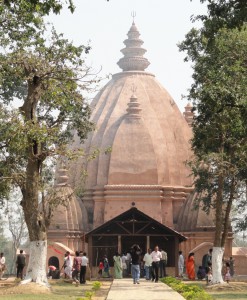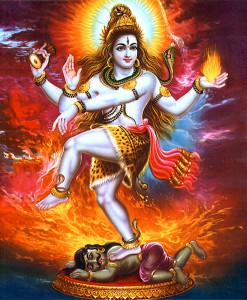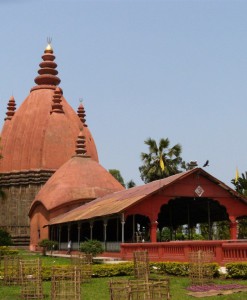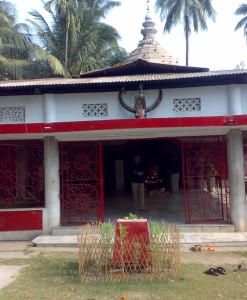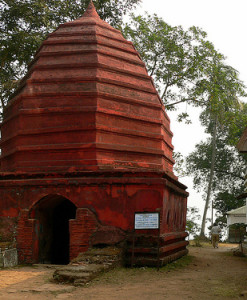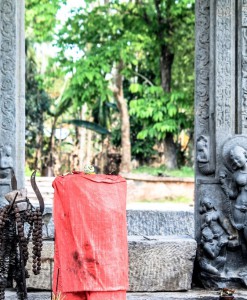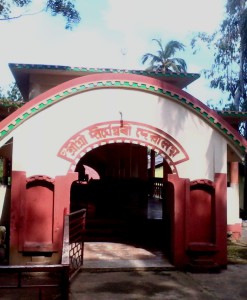No products in the cart.
The Umananda temple is located on a small island on the Brahmaputra River. The island is called Peacock Island and perhaps is the smallest river island in the world. To visit this place you will need to take a ferry ride from the banks. There is a small hill on the island sheltering the temple namely, Bhasmacala.
This shiv temple was built by the famous Ahom King Gadadhar Singha (1681 – 1696), who was the husband of Sati Joymati a great devout of Shiva. The original temple was however immensely damaged by a devastating earthquake of 1897. Later, it was reconstructed by a rich local merchant who chose to inscribe the interior part of a Siva temple with Vaisnavite slogans. In Assamese Uma means Hindu goddess Parvati, the wife of Shiva; and ananda means happiness which is also known as smallest inhabited river island in the world. This is one of the mostly visited temple in Assam which is devoted to Lord Shiva.
Umananda Temple, Guwahati;
- Temple History
- Legend
- Architecture
- How To Reach The Temple
- Daily Poojas And Festivals
- Videos
- Additional Information
The temple of Umananda was built in 1694 A.D. by the Bar Phukan Garhganya Handique by the order of King Gadadhar Singh (1681–1696), one of the ablest and strongest rulers of the Ahom dynasty. The original temple was however immensely damaged by a devastating earthquake of 1897. Later, it was reconstructed by a rich local merchant who chose to inscribe the interior part of a Siva temple with Vaisnavite slogans.
According to the ancient Hindu texts Kalika Purana, lord Siva is said to have resided here in the form of Bhayananda. In the beginning of the creation Siva sprinkled ashes (bhasma) at this place and imparted knowledge to Parvati (his consort). It is said that, when Siva was in meditation on this hillock, Kamadeva interrupted his yoga and was therefore burnt to ashes by the fire of Siva’s anger and hence the hillock got the name Bhasmacala.
This mountain is also called Bhasmakuta. The Kalika Purana states that Urvasikunda is situated here and here resides the goddess Urvasi who brings Amrit (nectar) for the enjoyment of Kamakhya and hence the island got the name Urvasi Island. It is believed that, worship here on the Amavasya day when it falls on Monday brings the highest bliss. The Siva Chaturdasi is the most colourful festival that is held here annually. Many devotees come to the temple on this occasion for the worship of the deity. Maha Shivaratri is widely celebrated in Umananda. Monday is considered to be the holiest day in the temple.
The temple has inherited some rock-cut figures, which speak passionately of the masterly skill of the Assamese craftsmen. The sculptures here show that the worshippers there followed all the principal Hindu gods. Representations of Surya, Ganesha, Shiva and Devi (with a scorpion as emblem) are found in the temple. In addition to those, Vishnu and his ten incarnations (avatar) are also found here. The main shrine is reached by a flight of steep steps.
To reach the umananda temple, one has to cross the river in a boat. It can be reached from Guwahati and North Guwahati by ferries and steamers. These boat services are available from the Kachari ghat. There is also a ferry service that is available from 7 am in the morning to 5 pm in the evening. One can hire a ferry from Sukleshwar ghat or Fancy Bazar Ghat.
By Rail: The Temple is well connected through nearest Guwahati railway station (1.6 km)
to major cities railway stations like Delhi, Agra, Mumbai, Chennai, Ajmer, Pali, Jaipur, Ahmedabad.
By Air: The Temple can be reached through nearest Guwahati Airport (21.9 Km) which is well connected with regular domestic flights to Delhi, Mumbai, Hyderabad, Bangalore, Chennai and other metropolitan cities.
The temple opens at 6:00 AM and closes at 6:00 PM. During this period rituals of lord Shiva are performed. Archana, Abhishekam and Arathi are the daily rituals performed in the temple.
It is believed that, worship here on the Amavasya day when it falls on Monday brings the highest bliss. The Siva Chaturdasi is the most colorful festival that is held here annually. Many devotees come to the temple on this occasion for the worship of the deity.
Basistha temple attracts pilgrims for the immense beauty. There are wells within the temple which is Shiva-shakti peeth. The shakti peeth is also known as tara peet. Siva linga of Mangaleshwar is hidden in the wells which is not visible. There is a cave which is 5 kms inside the ashram where Basistha muni meditated.




